VENUS LOVES THE 11th HOUSE
©Naomi C Bennett
excerpt from the 2014 book, Foundations of Astrology
Venus is the planet of attraction between people and it loves the 11th House. The 11th house has long been traditionally associated with friends and acquaintances; clubs, fraternities and societies; hopes and desires; promotion by recommendation of friends; astrologers. I would add in balance and design, mathematics, classical music and intimate relationships. In fact, I believe it is the original ruler of the 11th house, not Uranus. I think that the original Egyptian horoscopic astrology placed Venus/Libra in the 11th house but there is a long explanation for this that must be done to understand why.
It has only been since the 20th century that astrological authors have assigned Aries to the first house, Taurus to the second house, Gemini to the third house, Cancer to the fourth houses, etc. This is a very new invention over the past 110 years. The first astrologer that assigned Aries to the First House was the famous British astrologer Alan Leo in 1910. This was repeated by the famous American astrologer Evangline Adams in her astrology books. But as the current traditional American astrologer Lee Lehman states: “I have discovered that contemporary sources have completely obscured the essential differences between planet, sign and house. The concept that 1st House = Aries = Mars is mainly a modern invention.”
In 1992 I began a quest to confirm astrological theories that I had been taught, find their actual basis and verify the proof. I took multiple trips to Europe to look at Egyptian artifacts while searching for these clues. My searches lead me to London to the British Museum; to Paris to the Louvre; and to Egypt to Esna, Luxor, Dendera and Cairo. In the course of 20 years of research, some of my best discoveries were not found in astrological texts but in other fields like archeoastronomy, ancient mathematics and history. Luck, timing and synchronicity all played their part in piecing the puzzle together. Finally I think I now have enough verification to write about the first of these missing elements to help the advancement of astrology in this new century. The ancient Thema Mundi has co-rulerships of:
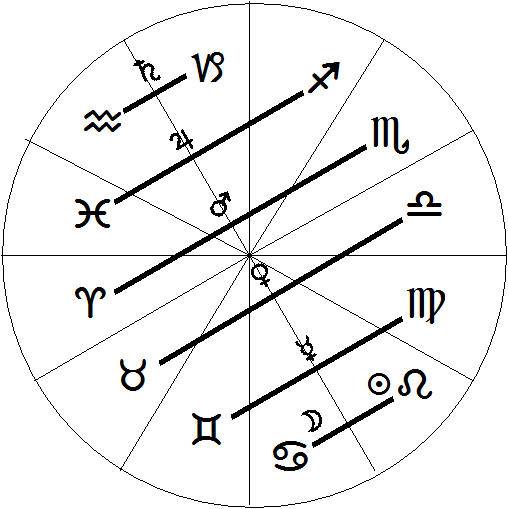
Classic Hellenistic sign and planet rulership
Cancer and Leo are the only signs solely assigned to a single luminary of the Moon and Sun respectively. Then the co-rulership signs go in order of Virgo-Gemini ruled by Mercury, Libra-Taurus ruled by Venus, Scorpio-Aries ruled by Mars, Sagittarius-Pisces ruled by Jupiter, and finally Capricorn-Aquarius ruled by Saturn. Starting with the Egyptian New Year at the summer solstice, they assigned the Moon to Cancer, and Sun to Leo, then Mercury to Virgo, Venus to Libra, etc. The Hellenistic Egyptians assigned planets to the astrological signs by Average Mean Distance from Earth.
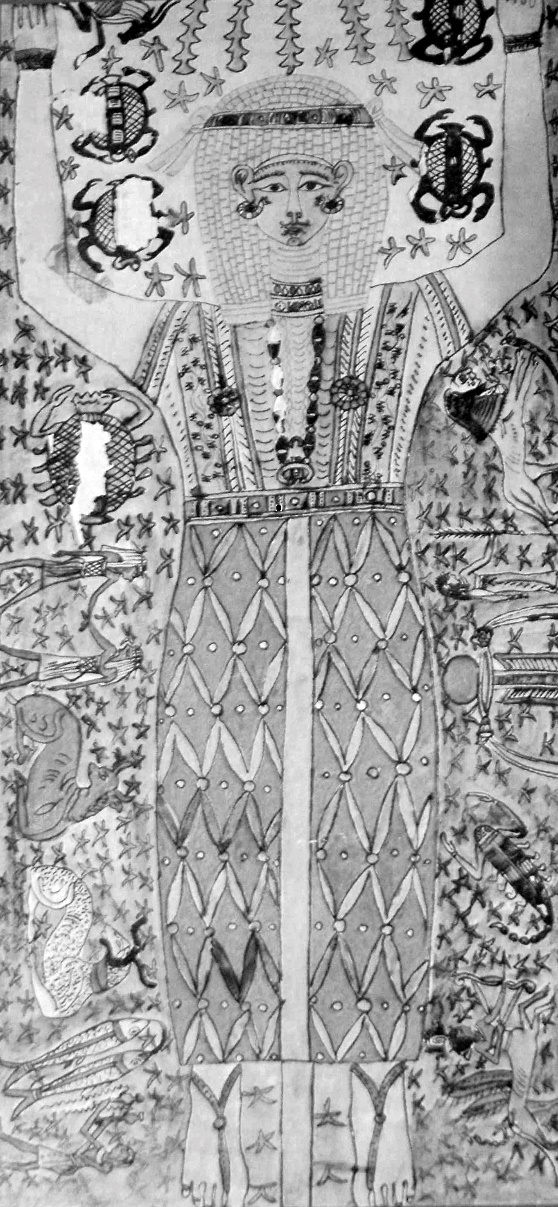
Goddess Nut from 200 A.D.
The first big stroke of luck for my research came at the Louvre in 1993. In the bookstore was a copy of the magazine, Archeologia with a picture of the Egyptian Sky Goddess Nut on the cover. She had the signs of the zodiac running down both sides of her body in the same co-rulership order as above. It was from the Hellenistic Egyptian period of 200 AD. (There are at least three of these images documented in various museums.) Inside the lid of the sarcophagus was the planetary order that I had been looking for. The order is very important. It starts with the two luminary signs of Leo and Cancer on opposite sides of her body. Leo and Cancer have single rulers and then the co-rulership signs extend down Nut’s body. The division of the signs between Leo and Cancer is not arbitrary. Cancer/Moon on the right is lunar and represents the Egyptian New Year with the summer solstice. Leo/Sun on the left is Solar so the element of duality is shown with this division. There is a hidden message in this arrangement. We must remember that secret societies or priesthoods held all ancient knowledge. Only the most trusted of leaders were taught the full knowledge that these groups held and maintained. The Greeks didn’t understand all they were taught and key elements were NOT explained to them.
This duality is representing the daily movement of the Earth’s rotation against the sky. This is the duality between the signs and houses represented by the division between Leo on the left and Cancer on the right. Another way to present this is to say that as we stand on the Earth, the vault of heaven with the zodiac signs and planets move above us while Earth appears to be fixed. This daily motion shows the planets and signs rise from the eastern horizon and set in the west while the zodiacal houses stay fixed to the observer’s location on Earth.
The Egyptians studied the sky for over 4,000 years. They were expert astronomers. They discovered that the Sun is closer to the Earth most of the time than Mercury or Venus!! This explains Hellenistic Planetary Order of Moon, Sun, Mercury, Venus, Mars, Jupiter and Saturn. Most astrologers do not know this basic astronomy and it’s not in astrology books.
Below is the astronomy of Mercury’s path around the Sun from a geocentric point of view. The key element is that most of Mercury’s transit time is outside the Sun’s circle. Mercury spends more time behind the Sun from the viewpoint of Earth. The loops are Mercury stations and retrograde periods.
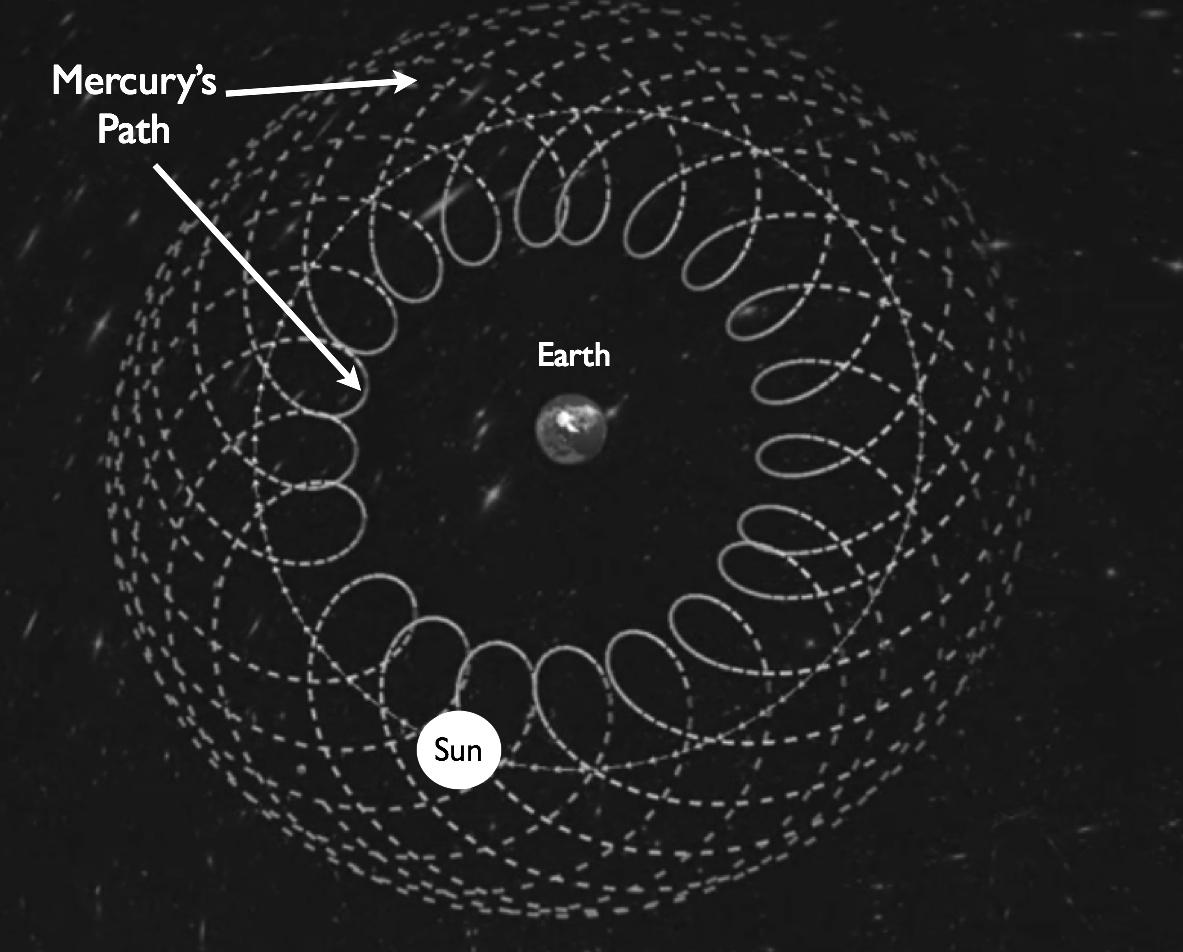
The second image is a screen shot from John Mick’s video of the Sun and Venus traveling around the Earth.
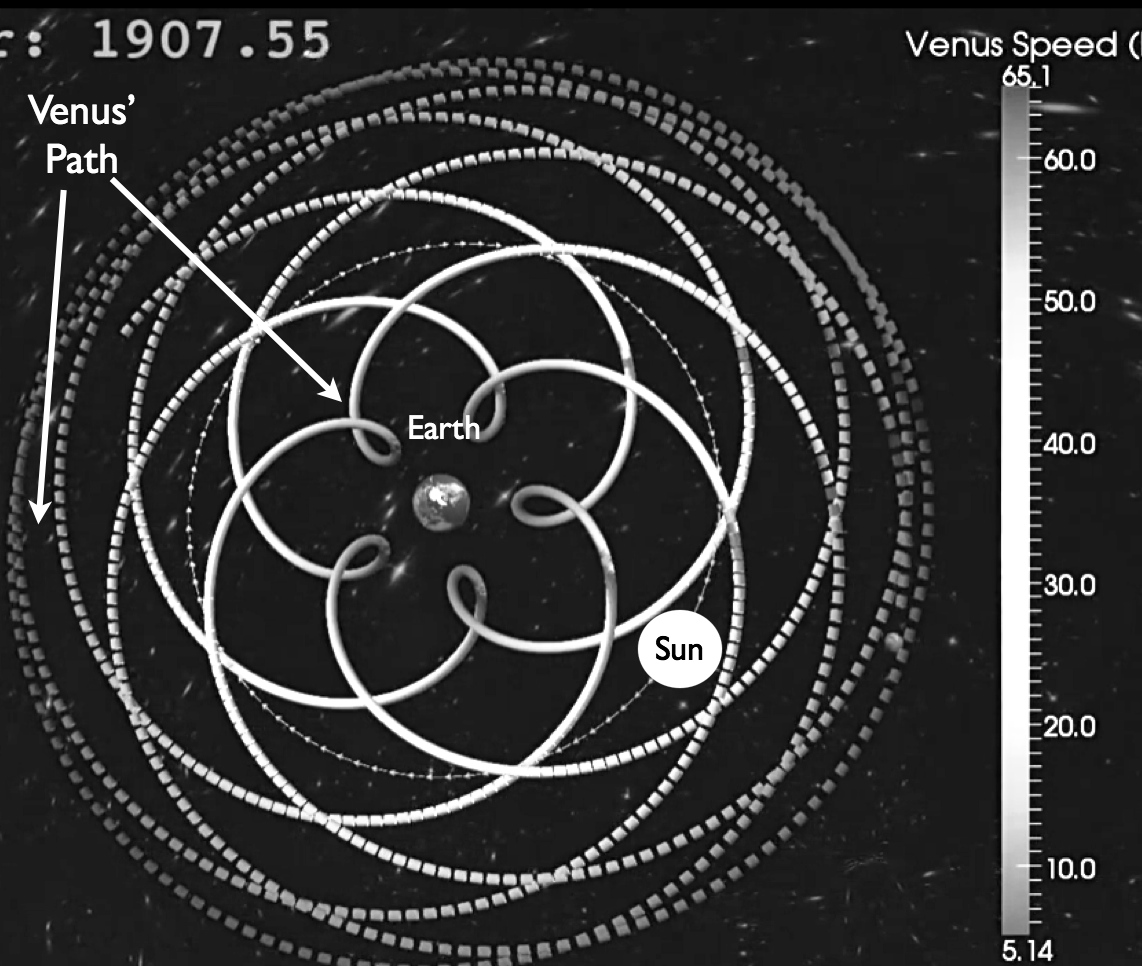
Venus and the Sun traveling around Geocentric Earth
It is very clear in both images that Mercury and Venus spend more time on the far side of the Sun. The Sun is closer to Earth during most times of the year than Mercury or Venus. When the inner planets of Mercury and Venus cross in front of the Sun’s path they slow down and then appear to us as being in retrograde motion. This is the proof that these ancient astrologers knew that the Sun is closest to the Earth, after the Moon, most of the time. . At least now there is strong evidence that average mean distance from Earth is the basis of the underlying pattern behind Hellenistic planetary order
As a minor side note, please remember that one of the original meanings of the word ‘rulership’ is ‘to rule’ or ‘ruler’ also meant to measure or to measure lengths. I believe this is the original meaning of rulership in astrology. It is to measure. Just like the Egyptians were the master geometers, they made Mercury the God of Measurement!
There is a renewed interest within our international astrological community in astrology’s foundations and origins since the 1990’s. Astrologers are attempting to ferret out the answers to the long debate about the function of houses versus signs. Our global community is beginning to merge modern and traditional views into a post-modern astrology. As the internationally famous astrologer Rob Hand stated in 2005: “So we need to strike a balance between the modernist’s attitude and the traditionalist’s attitude.”
The British traditional astrologer Deborah Houlding clearly states this dilemma in her revised excellent book reviewing this debate in the 2006 edition of The Houses,Temples of the Sky. Robert Hand wrote the forward to the book and said:
“It may ultimately be true that modern astrology has to go its own way in sorting out the houses. But let us at least do so, if we must, knowing that we have exhausted the possibilities of the old traditions. With this book I believe that there is no excuse for ignoring the history of the tradition.”
Houlding’s book is a careful review of ancient and modern house meanings. She rejects the idea that there can be any association of sign rulership with the houses. She used the texts of Manilius, Firmicus, Al-Biruni, Lilly and Modern (she lumps all modern authors together) as comparisons of house meanings across time to show their consistency. Generally, during most of the 20th century, American astrologers followed the Aries house count of Aries ruling the first house, Taurus ruling the second house, Gemini to the third house, etc. until Pisces ruled the twelfth house. Houlding said in her Introduction:
“Since classical times houses have been one of the four essential components of astrology. Along with planets, signs and aspects, their 12-fold division of the celestial sphere forms a fundamental building block in astrological interpretation. Yet curiously, despite all the books that speak of the essential message of house meaning, very little existing contemporary literature to foster a true appreciation of that essence by illustrating where the meaning come from. The origin of their symbolism is poorly understood, and little effort has been made by modern astrologers to investigate and define their meaning... Within the contemporary theories of house meanings, there are presently only two that are given any real
credibility. The first is a rather glib assumption that the houses are associated with, and take their meaning from, the signs of the zodiac... Traditional rulerships will fall by the wayside as they become inexplicable through the sign-originated theory... the signs were adapted and broadened out to incorporate the meaning of the houses, which correspond with their natural zodiacal order... The purpose of this book is to illustrate that none of the current theories on signs and psychological wheels can be regarded as historically correct, and that neither do they offer a full and reliable insight into the ‘fundamentals’ of house meanings which the astrologer relies upon in practical application.”
I agree with her conclusion that none of her references satisfy house rulership, but she left out other ancient non-textual references and the American 20th century astrologer, Carl Payne Tobey. The image above of the Goddess Nut, Mistress of the Sky whose image dates back to 200 AD has a strong, clear astrological message. This image is between the time of Manilius (10 AD) and Firmicus (4th century AD) which Houlding references. It is important to expand our astrological material beyond our fragmented multi-translated textual references. These other sources should be included in this new definition of post-modern astrology for the 21st century.
Tobey had a completely different view on signs and houses from that of the majority of astrologers. He was part of a group of investigative New York City based astrologers in the 1930’s and 40’s that were trying to dissect astrology and understand its foundations. Sydney K. Bennett (aka Wynn) studied Sanskrit in order to read Indian texts. Grant Lewi was also part of this group. Tobey and Lewi were best friends. Others were Charles Jayne and Dane Rudhyar. They all socialized and published articles in the same American astrology magazines edited by Lewi. Lewi only used transits and he didn’t use the Aries house count, he dropped all house rulerships. He just called the houses ‘sectors’ in his book, Astrology for the Millions. Tobey was the resident statistician of the group. He gathered thousands of birthdates and hand calculated the data to prove basic principals long before there was the French statistician, Michel Gauquelin. Tobey loved mathematics and pursued his study of number theory and geometry as his own personal interest. He was always trying to figure out the puzzle of the underlying foundation of astrological design. He firmly believed that astrology was a branch of geometry applied to life on Earth.
The Egyptians placed great importance on the Sun being reborn every morning at sunrise and dying at sunset as the Goddess Nut swallowed the Sun. The Sun traveled down Nut’s body during the night to be reborn the next morning. Note that the Egyptians were obsessed with the horizon at the Ascendant (sunrise) and the Descendant (sunset). They were constantly tracking the distance between the Sun and the horizon.
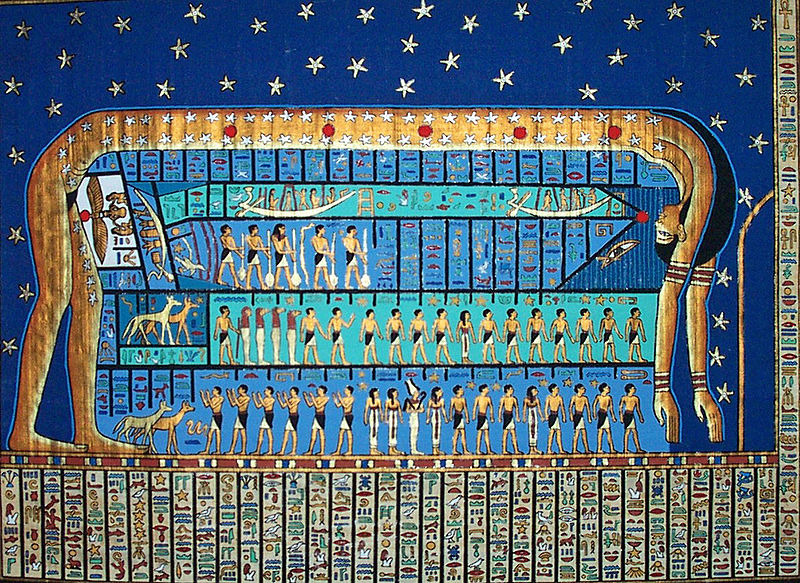
Goddess Nut swallowing the Sun to be reborn at Sunrise
There is another level of meaning behind this image of Nut, Goddess of the Sky with the God Geb representing Earth in coitus together. This is the duality of a rotating Heaven with a fixed Earth. They do a daily dance each day creating life on Earth. The duality of opposite motion splits the zodiac between Cancer and Leo. This structure is present in the meaning of the astrological signs and houses we use in astrology today.
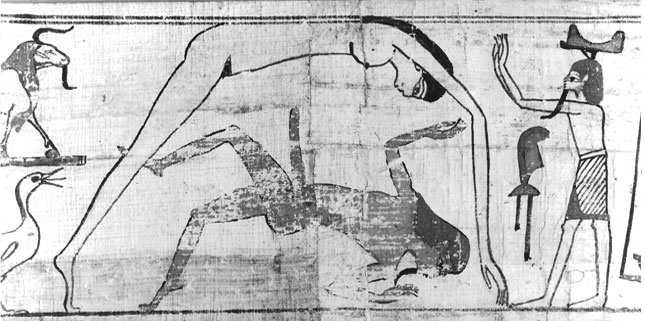
The Earth God Geb with the Sky Goddess Nut in Eternal Coitus
The Hellenistic period consisted of an amalgamation of concepts that have become our Western horoscopic astrology of today. This dual structure of opposite motion between Cancer and Leo is still present in the meaning of the astrological houses we use today in astrology. The most common house meanings per Houlding are below but I have started them with Leo. See how well the meaning fit this arrangement of signs to houses:
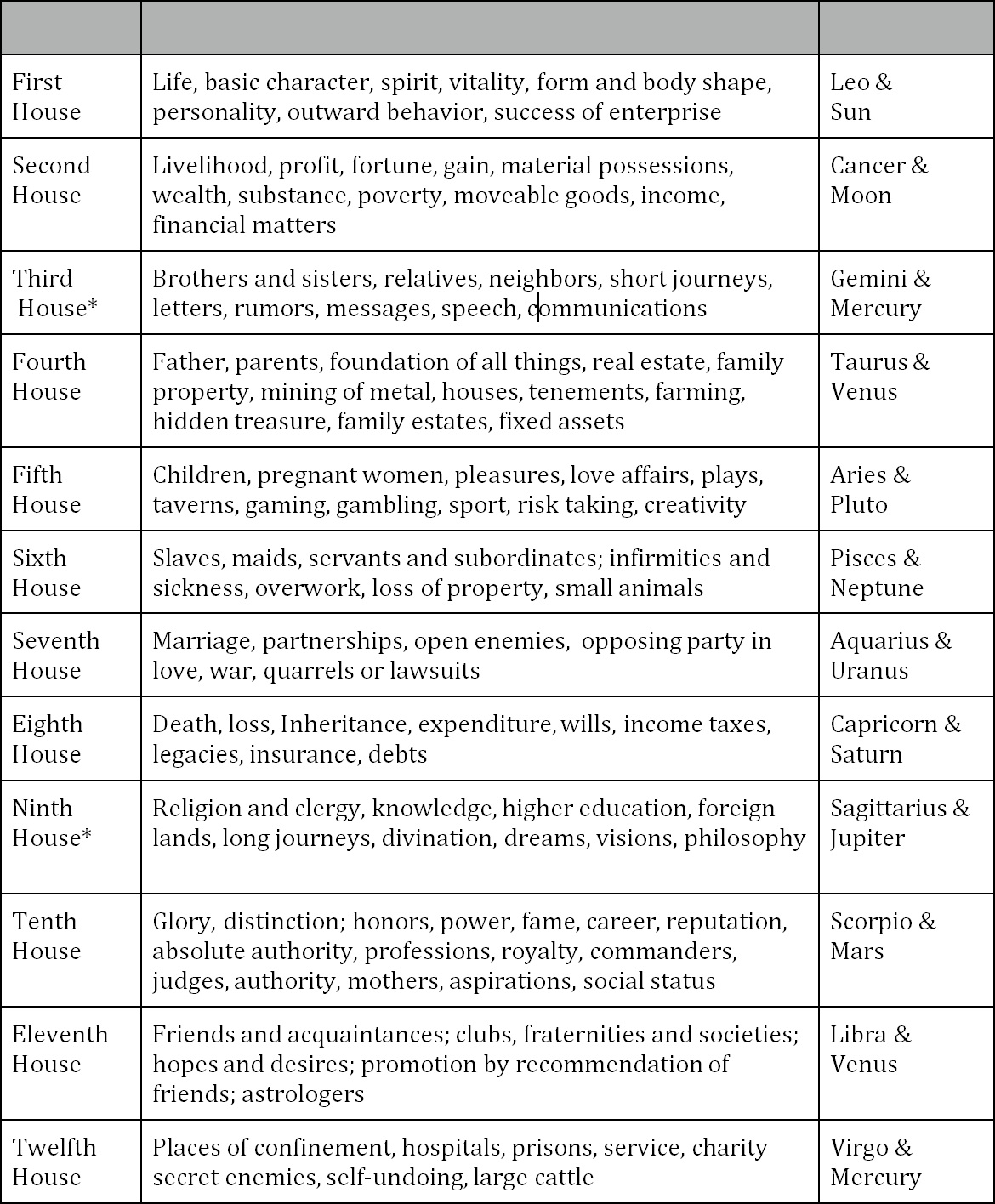
* Whether the count starts with Aries or Leo, the 3rd and 9th house rulerships of Gemini and Sagittarius remain the same.
It has only been since the 20th century that astrological authors have assigned Aries to the first house, Taurus to the second house, Gemini to the third house, Cancer to the fourth houses, etc. This is a very new invention over the past 110 years
One influence to the Aries House assignments might be attributed to Evangeline Adams because Aleister Crowley was her ghost writer for her popular book, Astrology, Your Place in the Sun (1927). Crowley was British and influenced by Alan Leo. Because of Alan Leo, and his Aries house count, it put Scorpio on the Eighth house, so sex was added to the Eighth house this last century. Sex was never associated with the Eighth as Houlding clearly demonstrates. Other than minor attributes assigned to modern houses, the majority of house functions are basically intact from early writers. The Leo House Count fits perfectly with the traditional meanings, except there is confusion about the Sixth - Twelfth axis.
Twelfth House15
Firmicus: enemies, slaves, defects, illness, bad spirit.
Al-Biruni: enemies, misery, prison, fines, fear, disease, cattle, slaves, servant, exile
Lily: secret enemies, witches, self-undoing, imprisonment, horses, oxen elephants
Moderns: Seclusion, service, charity, unconscious, escapism, mysticism.
Sixth House16
Firmicus: infirmities and sickness
Al-Biruni: sickness, body defects, overwork, slaves, maids
Lily: sickness and disease, servants, labourers, small animals.
Moderns: work, subordinates, chores, health
We have various writers confusing health and sickness, work and subservience, secret enemies, fate and karma between these two houses. The karmic association comes from the Vedic tradition of associating the lunar nodes (which the Jyotish consider to be karmic) with the Twelfth House. This is not seen in the Hellenistic Greeks, they don’t mention karma.
Our astrological community has been quite limited in that all the recent research of astrological history is constrained only to written texts. In other areas of study such as archeoastronomy, there has been a great emergence of our astrological history cloaked in words like shaman-priests (astrologers) and sky myths/omens (astrological predictions). There is an avoidance of using the word ‘astrology’ but the research clearly reveals ancient temple alignments to stars and the layout of whole ancient cities with a purposeful design to create Heaven on Earth. We need to study and incorporate these astrological images that hold hidden information in our study of this very old practice and modern usage of Heaven on Earth. I know that this will disturb the traditionalists but I am attempting to bring in the ancient astronomical and geometric basis of how Hellenistic astrology was designed. It will disturb some modern astrologers that are invested with Aries ruling the First House, but as Rob Hand said, ”it’s time to marry the modern with the traditional in order to have a functional whole for the 21st century.” The table above maintains all of the traditional house functions. The only exception is the Sixth and Twelfth but even these two are only changing which function belongs between them. Carefully look at the traditional list of house functions and see how well the Leo house count fits them like a glove.
I believe this is the correct rulership of the houses, a long debated issue that has not been put to rest. This is the most logical explanation for the design behind the houses. I hope that open-minded people will investigate the truth in these discoveries. I have worked with this design for over 40 years and Tobey worked with it for another 50 years before me, along with his 700+ students. It functions well and gives a new perspective on the original design of horoscopic astrology.
So with the Leo House Count, Venus-Libra is the natural original rulership to the attributes of the 11th House. This is the house of beauty—the beauty of Leonardo de Vinci’s Mona Lisa, the beauty of a perfectly balanced Greek architecture, a beautifully composed classical music, the beauty that comes from a perfectly balanced mathematical formula, the attraction of people who instantly like each other. It is Venus that brings friends, associates and lovers into our lives. We see this in social groups that create clubs, sororities and fraternities of similar likes and values. This is why astrology is associated with the 11th house. Astrology is a branch of mathematics—fractal geometry. It is the study of abstract design applied to life on Earth. Astrology is ruled by Venus and Libra, the natural rulers of the 11th House! Yes, Venus loves the 11th house. It IS the home of Venus-Libra.
This is explained in more detail in my book Foundations of Astrology available on Amazon and available for sale at this conference. naomibennett9@yahoo.com